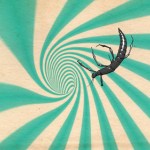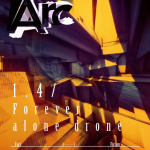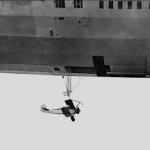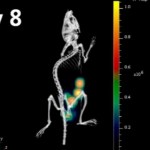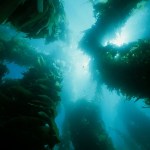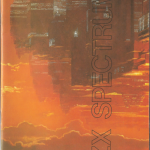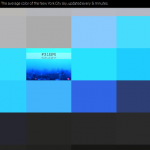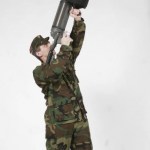awesome
Director Jilli Rose has made a short animated documentary about everyone's favourite back-from-the-dead, hiding-on-an-impenetrable-Pacific-island-fortress tree lobster.
Jilli says:
So many conservation stories are grim and worrying, it's easy to feel hopeless in the face of them. I want to drop a good story into the mix, to uplift and hopefully energise viewers, particularly kids, and to inspire them to care about the fate of creatures that may not be what they usually consider "cute" or "cuddly". Our film is heartwarming, funny, engaging, beautiful, lively, colourful and hopeful.…
I'm thrilled to be included amongst some sterling writers in the new issue of Arc magazine, Forever Alone Drone, discussing how urban exploration can act as a foil to the increasingly restrictive environment of cities. Public spaces are being sold off to private owners at an alarming rate, who can prohibit entirely legal behaviours and even exclude entire groups of people. In the future, simply getting from A to B might require a set of skills that currently only a few brave pioneers possess. Here's a short extract:
Elevators can be hijacked with triangular lift keys and sent to hidden floors…
Nasa's Jet Propulsion Laboratory and NPR both have features on watchmaker Garo Anserlian, who designed a special watch that keeps time with Martian solar days. Snip:
The martian day is longer than Earth's, but this minimal variance can amount to physical and mental fatigue. Every day, team members are reporting to work 39 minutes later than the previous day.
"Everything on this mission is based on local solar time on Mars," said Julie Townsend, Mars Exploration Rover avionics systems engineer. "From home, during the mission practice tests, it was very difficult to constantly translate…
Some time back, I pitched a few editors the idea of doing something on a new breed of airborne aircraft carriers. Sadly it didn't stick, because no one had invented them yet. Such are the constraints of writing non-fiction. Reality has a way of catching up though, and New Scientist broke the news today about the latest in air tech: floating fortresses that dispense drones and guided missiles on command.
The concept of an airborne aircraft carrier is not new. Almost as soon as we were in the air, we started trying to compound air power by sticking one craft on top of (or under, or alongside)…
This three-story-tall mural was painted by international artist Josef Kristofoletti on the side of the ATLAS control room directly above the detector:
This project was inspired by the same questions that physicists are trying to answer; where did we come from, what does it mean to be human, and what is our place in the universe? The artist worked closely with physicists at CERN over the course of a year to create the mural. It depicts the artist's interpretation of what the Higgs boson might look like.
This short, time-lapse video was finished June 2012, using photos that were taken…
The BBC reports that for the first time, scientists have been able to watch the an infection develop in real time, inside an animal. The best part? They used a special glowing bacteria and measured the rays of light escaping from the animal's body:
The researchers used a genetically modified version of a mouse bug, Citrobacter rodentium, which produces light.
Dr James Collins, who works in Prof Frankel's lab, then puts the infected mice inside the scanner.
"It is a dark box which keeps the animals warm and blocks any other light from coming in. It has a camera at the top so we can very…
I grew up on the coast of California, and I loved to surf. At my favorite break, Pleasure Point, the best waves were often at low tide, but low tide also meant seaweed. Lots of seaweed.
[Source]
The giant kelp of Monteray Bay is an astonishing organism. It's not actually a plant, it's a brown algae, and it can grow 12 inches per day. This rapid growth makes it an ideal resource, and a bane of surfers that get their fins caught in thick mats.
You can't tell, but it was definitely kelp that made me fall, not the fact that I was too far forward and unable to turn. No, really...
Brown algae…
Toward the end of last year, being in possession of two novelties - a girlfriend and a steady job - I decided to spend my free evenings crafting a very special piece of jewellery. I was inspired by a visit to Barometer World in the late summer, where I discovered the curious material known as storm glass (tragic backstory recounted here).
In short, a storm glass is a weather divination tool so old that nobody really knows where they came from. It's likely they were borne out of alchemy experiments performed during the medieval period. Inside a sealed glass tube, crystals bloom, wither and…
Last week I had a visit from a friend of mine, who was on something of a farewell tour. After several years of planning, he'd packed in his dependable but much-begrudged corporate job, and was setting sail for Asia, to see more of the world. He's already seen much more of the world than most people. Not because he was well connected or rich, but because he made it his life's mission to tour the forgotten, the hidden and the forbidden places of the world. I mention this because if there ever was a man to take life advice from, it is this one, and he put into words something I've been…
Today I'll be writing a series of blogposts from the Falling Walls conference in Berlin. Each speaker is invited to discuss the ideas, inventions, and discoveries they believe will break down walls in their field.
Robert E. Horn: How Visual Language Supports Decision Making About Wicked Problems and Social Messes
Let's face it, having "messes" listed as a research specialism on your business card is pretty neat. But Stanford's Robert Horn is exactly that, a man who studies messes, or more accurately "inter-related sets of problems", particularly because business and government strategies…
As it's shaping up to be my final days in Devon, me and my #1 Nerd travelled to Barometer World, a pilgrimage we'd been promising to make since the start of summer. As the name suggests, it's a Mecca of meteorological wonder, boasting hundreds of aneroid and mercury barometers, barographs, thermometers, hygrometers and thunder bottles. It's a bargain at £2.50 and I encourage everyone to go.
What intrigued me most of all, though, was the strange crystals attached to many of the old barometers. This, I was told, was storm glass, a curiosity whose origins are hidden in the mists of time.
Back in…
Science is awesome.
Click the image to biggify.
The European Southern Observatory says:
The first European antenna for the Atacama Large Millimeter/submillimeter Array (ALMA) has reached new heights, having been transported to the observatory's Array Operations Site (AOS) on 27 July 2011. The 12-metre diameter antenna has arrived at the Chajnantor plateau, 5000 metres above sea level. Here, it joins antennas from the other international ALMA partners, bringing the total number at the AOS to 16.The plateau's elevated location -- 2100 metres higher than the OSF -- gives it the extremely dry…
No sooner than the smell of low Earth orbit had worn off the space shuttle Atlantis, Nature editor Adam Rutherford was stitching together footage of its final mission into this wonderful tribute to the golden age of manned spaceflight.
Adam says:
I've made a short music video for Nature and Scientific American marking the end of the Space Shuttle era. It consists of every single one of the 135 missions, in order, set to the a music of 65daysofstatic. It is my love letter to the Space Shuttle.The editing was done by Charlotte Stoddart and Dave Holloway, and the music was remixed by Paul…
I miss the 80s, when computing manuals were illustrated with things far removed from home computing. I found this amongst my pop's old computing books.
Nowadays off-the-shelf programming software tends to be designed for a specific purpose, and I like to think that the artist here was trying to capture the infinite possibilties that lay ahead at the dawn of home computing, but perhaps I'm just being sentimental.
Wait, there's more!
Artist Mike Bodge has unveiled a nifty project to chart the colour of the sky above New York City in real time. A camera installed in his office snaps a picture of the skyline every five minutes, and analyses the image to calculate its average colour. The varying shades of blue, grey, orange and black are posted online in a never-ending mosaic.
Mike says:
Many of my projects tend to be about New York City, as it's a place i'm constantly inspired by. I have a great view at my office overlooking the East Village neighborhood and I've done time lapses and other things but none really…
The Smithsonian has a cool post on wingless ants that have learned how to glide through the forest canopy using their outstretched legs. If knocked from their treetop nest, Cephalotes atratus avoid falling to the ground by steering themselves, tail first, back toward the tree. Yes, not only can these ants glide, they do it backwards.
Full details over at the Smithsonian Science blog.
When the judges sat down to award this year's $500,000 Lemelson-MIT prize for innovation, there were a slew of fantastic inventions to choose from. Implantable computers, ultra-low-cost cameras, a revolutionary solar panel design. Luckily for the judges all three were invented by one man: Dr John A Rogers.
Seemingly cut from the same cloth as previous Lemelson-MIT recipient and Renaissance man Erez Aiden (see Ed Yong's excellent piece here), Roger's creations have spanned a disparate collection of sciences, and he himself credits his success to an appreciation for both science and the…
So a few weeks back we had a super-nerdy science party, and I thought you might like to know how to mount your own. So here's how to make delicious desserts that look like bacterial cultures. This works builds on previous research carried out by Rehorst et al.
You'll need:
Petri dishes
Jello
Rice pudding
Angel Delight
Lab notebook
Protective clothing
Rum (optional)
Jelly sweets
Food colouring
Icing for decorating cookies
And any of the following: cocoa, brown sugar, maple syrup, cake decorations, chocolate drops...
Click below the fold for more....
1. Collect your ingredients. If you're…
How do bees chat to one another? By shaking their funky butts, of course! This video was made by Andy Quitmeyer, a digital media Master's student, for Georgia Tech's MARS lab, in a project funded by the US National Science Foundation.
Bees were one of my favourite subjects when I was studying for my biology degree, who couldn't fall in love with these adorable little chaps*?
*actually, all the bees you see here are female. The males don't work, they just gorge themselves on honey, mate, and die. If you think that sounds fun, bear in mind that they die because the penis is torn off during…
Live out your superhero fantasies with this grappling hook gun from Battelle. It shoots 100 feet up and 60 feet across, easily enough to scale ten storeys to your enemy's hideout. They say:
The Tactical Air Initiated Launch (TAIL) system is used to propel a titanium grappling hook towing a Kevlar line for use in Visit Board Search and Seizure (VBSS) operations. It also can be used for fire rescue operations, life vest deployment, or other activities.Besides enhanced performance at reduced cost, the TAIL system's simple, rugged design boosts safety and reliability with the advantage of low…
